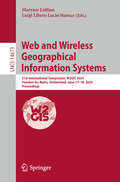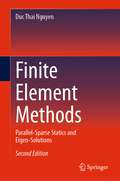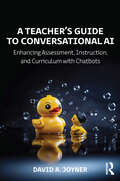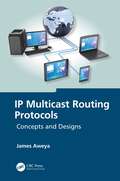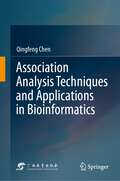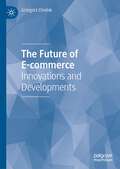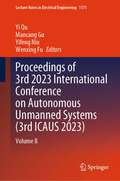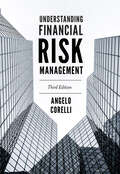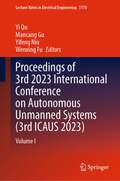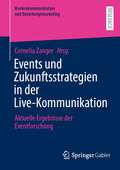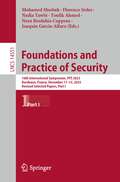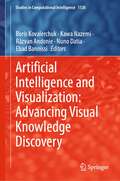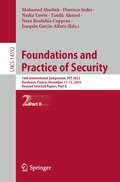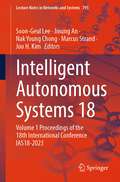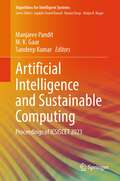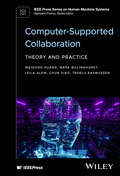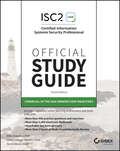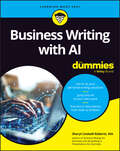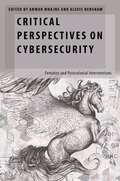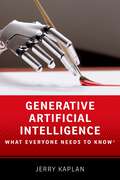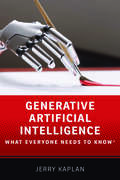- Table View
- List View
Web and Wireless Geographical Information Systems: 21st International Symposium, W2GIS 2024, Yverdon-les-Bains, Switzerland, June 17–18, 2024, Proceedings (Lecture Notes in Computer Science #14673)
by Maryam Lotfian Luigi Libero Lucio StaraceThis book constitutes the refereed proceedings of the 21st International Symposium on Web and Wireless Geographical Information Systems, W2GIS 2024, held in Yverdon-les-Bains, Switzerland, during June 18–19, 2024. The 8 full papers and 7 short papers included in this book were carefully reviewed and selected from 20 submissions. The book also contains one invited talk. They were organized in topical sections as follows: Spatiotemporal Data Analysis, Open Data and Reproducible Research, Geospatial Technologies and Tools, Advanced Computing and GIS Applications, Transportation Applications, and Doctoral Symposium.
Finite Element Methods: Parallel-Sparse Statics and Eigen-Solutions
by Duc Thai NguyenThis new edition includes three new chapters, 7 through 9, that have very broad, practical applications in engineering and science. In addition, the author’s latest research results incorporated into the new textbook demonstrates better performance than the popular METIS software for partitioning graphs, partitioning finite element meshes, and producing fill-reducing orderings for sparse matrices. The new Chapter 8, and its pre-requisite, Chapter 7, present a state-of-the-art algorithm for computing the shortest paths for real-life (large-scale) transportation networks with minimum computational time. This approach has not yet appeared in any existing textbooks and it could open the doors for other transportation engineering applications. Chapter 9 vastly expands the scope of the previous edition by including sensitivity (gradient) computation and MATLAB’s built-in function “fmincon” for obtaining the optimum (or best) solution for general engineering problems.
A Teacher’s Guide to Conversational AI: Enhancing Assessment, Instruction, and Curriculum with Chatbots
by David A. JoynerA Teacher’s Guide to Conversational AI explores the practical role that language-based artificial intelligence tools play in classroom teaching, learning experiences, and student assessment. Today’s educators are well aware that conversational and generative AI—chatbots, intelligent tutoring systems, large language models, and more—represent a complex new factor in teaching and learning. This introductory primer offers comprehensive, novice-friendly guidance into the challenges and opportunities of incorporating AI into K-12 schools and college classes in ways that are appropriate, nourishing to students, and outcomes-driven.Opening with an informative overview of the foundational properties, key terminology, and ethical considerations of these tools, the book offers a coherent and realistic vision of classrooms that are enhanced, rather than stymied, by AI systems. This includes strategies for:· designing assessments that are conducive to students’ beneficial use of AI while mitigating overreliance or dishonesty;· using AI to generate lesson examples for student critique or custom content that reinforces course principles;· leveraging chatbots as a co-instructor or a tutor, a guide during student-driven learning, a virtual debate or brainstorming partner, and a design project; and· creating course content, lesson plans and activities, expanded language and accessibility options, and beyond. Through the depth of understanding and applied approach provided in these chapters, teachers and leaders in training and in service, alongside private tutors, college instructors, and other educators, will be better prepared to future-proof their efforts to serve new generations of learners.
IP Multicast Routing Protocols: Concepts and Designs
by James AweyaThis book discusses the fundamental concepts that are essential to understanding IP multicast communication. The material covers the well‑known IP multicast routing protocols, along with the rationale behind each protocol. The book starts with the basic building blocks of multicast communications and networks, then progresses into the common multicast group management methods used, and finally into the various, well‑known multicast routing protocols used in today’s networks. IP multicast provides significant benefits to network operators by allowing the delivery of information to multiple receivers simultaneously with less network bandwidth consumption than using unicast transmission. Applications that can benefit greatly from multicast communications and multicast‑enabled networks include audio and video conferencing, collaborative computing, online group learning and training, multimedia broadcasting, multi‑participant online gaming, and stock market trading. This book’s goal is to present the main concepts and applications, allowing readers to develop a better understanding of IP multicast communication. IP Multicast Routing Protocols: Concepts and Designs presents material from a practicing engineer’s perspective, linking theory and fundamental concepts to common industry practices and real‑world examples. The discussion is presented in a simple style to make it comprehensible and appealing to undergraduate‑ and graduate‑level students, research and practicing engineers, scientists, IT personnel, and network engineers. It is geared toward readers who want to understand the concepts and theory of IP multicast routing protocols, yet want these to be tied to clearly illustrated and close‑to‑real‑world example systems and networks.
A Teacher’s Guide to Conversational AI: Enhancing Assessment, Instruction, and Curriculum with Chatbots
by David A. JoynerA Teacher’s Guide to Conversational AI explores the practical role that language-based artificial intelligence tools play in classroom teaching, learning experiences, and student assessment. Today’s educators are well aware that conversational and generative AI—chatbots, intelligent tutoring systems, large language models, and more—represent a complex new factor in teaching and learning. This introductory primer offers comprehensive, novice-friendly guidance into the challenges and opportunities of incorporating AI into K-12 schools and college classes in ways that are appropriate, nourishing to students, and outcomes-driven.Opening with an informative overview of the foundational properties, key terminology, and ethical considerations of these tools, the book offers a coherent and realistic vision of classrooms that are enhanced, rather than stymied, by AI systems. This includes strategies for:· designing assessments that are conducive to students’ beneficial use of AI while mitigating overreliance or dishonesty;· using AI to generate lesson examples for student critique or custom content that reinforces course principles;· leveraging chatbots as a co-instructor or a tutor, a guide during student-driven learning, a virtual debate or brainstorming partner, and a design project; and· creating course content, lesson plans and activities, expanded language and accessibility options, and beyond. Through the depth of understanding and applied approach provided in these chapters, teachers and leaders in training and in service, alongside private tutors, college instructors, and other educators, will be better prepared to future-proof their efforts to serve new generations of learners.
IP Multicast Routing Protocols: Concepts and Designs
by James AweyaThis book discusses the fundamental concepts that are essential to understanding IP multicast communication. The material covers the well‑known IP multicast routing protocols, along with the rationale behind each protocol. The book starts with the basic building blocks of multicast communications and networks, then progresses into the common multicast group management methods used, and finally into the various, well‑known multicast routing protocols used in today’s networks. IP multicast provides significant benefits to network operators by allowing the delivery of information to multiple receivers simultaneously with less network bandwidth consumption than using unicast transmission. Applications that can benefit greatly from multicast communications and multicast‑enabled networks include audio and video conferencing, collaborative computing, online group learning and training, multimedia broadcasting, multi‑participant online gaming, and stock market trading. This book’s goal is to present the main concepts and applications, allowing readers to develop a better understanding of IP multicast communication. IP Multicast Routing Protocols: Concepts and Designs presents material from a practicing engineer’s perspective, linking theory and fundamental concepts to common industry practices and real‑world examples. The discussion is presented in a simple style to make it comprehensible and appealing to undergraduate‑ and graduate‑level students, research and practicing engineers, scientists, IT personnel, and network engineers. It is geared toward readers who want to understand the concepts and theory of IP multicast routing protocols, yet want these to be tied to clearly illustrated and close‑to‑real‑world example systems and networks.
Association Analysis Techniques and Applications in Bioinformatics
by Qingfeng ChenAdvances in experimental technologies have given rise to tremendous amounts of biology data. This not only offers valuable sources of data to help understand biological evolution and functional mechanisms, but also poses challenges for accurate and effective data analysis. This book offers an essential introduction to the theoretical and practical aspects of association analysis, including data pre-processing, data mining methods/algorithms, and tools that are widely applied for computational biology. It covers significant recent advances in the field, both foundational and application-oriented, helping readers understand the basic principles and emerging techniques used to discover interesting association patterns in diverse and heterogeneous biology data, such as structure-function correlations, and complex networks with gene/protein regulation. The main results and approaches are described in an easy-to-follow way and accompanied by sufficientreferences and suggestions for future research. This carefully edited monograph is intended to provide investigators in the fields of data mining, machine learning, artificial intelligence, and bioinformatics with a profound guide to the role of association analysis in computational biology. It is also very useful as a general source of information on association analysis, and as an overall accompanying course book and self-study material for graduate students and researchers in both computer science and bioinformatics.
The Future of E-commerce: Innovations and Developments
by Grzegorz ChodakThe e-commerce industry is growing year by year, with the COVID-19 pandemic having greatly accelerated this process. In response to the massive growth, this book analyses future trends in e-commerce, focusing on its importance in some parts of the economy as well key innovations, which include future logistics solutions such as automated delivery robots. The most extensive part of the book is dedicated to exploring virtual reality in e-commerce, where the author presents research on the usage of VR goggles in online stores and discusses the potential advantages and threats. Also covering key topics such as the future of payment methods, AR as an e-commerce enhancement and the direction of its development, as well as AI methods (such as ChatGPT to generate content in an online shop), this book is a key resource for anyone studying e-business.
Proceedings of 3rd 2023 International Conference on Autonomous Unmanned Systems: Volume II (Lecture Notes in Electrical Engineering #1171)
by Yi Qu Mancang Gu Yifeng Niu Wenxing FuThis book includes original, peer-reviewed research papers from the 3rd ICAUS 2023, which provides a unique and engaging platform for scientists, engineers and practitioners from all over the world to present and share their most recent research results and innovative ideas. The 3rd ICAUS 2023 aims to stimulate researchers working in areas relevant to intelligent unmanned systems. Topics covered include but are not limited to: Unmanned Aerial/Ground/Surface/Underwater Systems, Robotic, Autonomous Control/Navigation and Positioning/ Architecture, Energy and Task Planning and Effectiveness Evaluation Technologies, Artificial Intelligence Algorithm/Bionic Technology and their Application in Unmanned Systems.The papers presented here share the latest findings in unmanned systems, robotics, automation, intelligent systems, control systems, integrated networks, modelling and simulation. This makes the book a valuable resource for researchers, engineers and students alike.
Understanding Financial Risk Management
by Angelo CorelliFinancial risk management is a topic of primary importance in financial markets. It is important to learn how to measure and control risk, how to be primed for the opportunity of compensative return, and how to avoid useless exposure. This third edition of Understanding Financial Risk Management offers an updated version of its innovative approach to such issues. Angelo Corelli analyses the various types of financial risk that a financial institution now face in everyday operations—including market, interest rate, credit, liquidity, operational, currency, volatility, and enterprise risk. He deals with each type of risk using a rigorous mix of analytical and theoretical approaches; he gives introductory overviews to the most relevant statistical and mathematical tools; and he provides innovative analyses of all the major models available in the literature. This broad view of theory and the current state of the industry provides a friendly but serious starting point for those who encounter risk management for the first time, and it offers plenty of food for thought to more advanced readers. For its unique mix of rigour and accessibility, this book is a must-read for finance professionals, and it is of keen interest to finance students and researchers.
Understanding Financial Risk Management
by Angelo CorelliFinancial risk management is a topic of primary importance in financial markets. It is important to learn how to measure and control risk, how to be primed for the opportunity of compensative return, and how to avoid useless exposure. This third edition of Understanding Financial Risk Management offers an updated version of its innovative approach to such issues. Angelo Corelli analyses the various types of financial risk that a financial institution now face in everyday operations—including market, interest rate, credit, liquidity, operational, currency, volatility, and enterprise risk. He deals with each type of risk using a rigorous mix of analytical and theoretical approaches; he gives introductory overviews to the most relevant statistical and mathematical tools; and he provides innovative analyses of all the major models available in the literature. This broad view of theory and the current state of the industry provides a friendly but serious starting point for those who encounter risk management for the first time, and it offers plenty of food for thought to more advanced readers. For its unique mix of rigour and accessibility, this book is a must-read for finance professionals, and it is of keen interest to finance students and researchers.
Proceedings of 3rd 2023 International Conference on Autonomous Unmanned Systems: Volume I (Lecture Notes in Electrical Engineering #1170)
by Yi Qu Mancang Gu Yifeng Niu Wenxing FuThis book includes original, peer-reviewed research papers from the 3rd ICAUS 2023, which provides a unique and engaging platform for scientists, engineers and practitioners from all over the world to present and share their most recent research results and innovative ideas. The 3rd ICAUS 2023 aims to stimulate researchers working in areas relevant to intelligent unmanned systems. Topics covered include but are not limited to: Unmanned Aerial/Ground/Surface/Underwater Systems, Robotic, Autonomous Control/Navigation and Positioning/ Architecture, Energy and Task Planning and Effectiveness Evaluation Technologies, Artificial Intelligence Algorithm/Bionic Technology and their Application in Unmanned Systems.The papers presented here share the latest findings in unmanned systems, robotics, automation, intelligent systems, control systems, integrated networks, modelling and simulation. This makes the book a valuable resource for researchers, engineers and students alike.
Events und Zukunftsstrategien in der Live-Kommunikation: Aktuelle Ergebnisse der Eventforschung (Markenkommunikation und Beziehungsmarketing)
by Cornelia ZangerDie Veranstaltungswirtschaft hat sich nach dem Lockdown auf den Weg zu einem „New Normal“ begeben, in dem Live- und digitale Kommunikation eng verbunden sind. In diesem Konferenzband werden interessante und bisher noch unbeantwortete Fragen angesprochen wie die Rolle von Metaverse als Kommunikationsplattform, die Customer Journey bei immersiver Live Kommunikation, der künftige Stellenwert hybrider Konzepte oder die strategische Neupositionierung von Messen. Im Buch wird auch über Untersuchungen zur Zahlungsbereitschaft von Veranstaltungsbesuchern, Nachhaltigkeit von Sportveranstaltungen, Veränderung des „Eco-System“ Veranstaltungswirtschaft infolge der digitalen Transformation und die Diversity in Agenturen berichtet.
Foundations and Practice of Security: 16th International Symposium, FPS 2023, Bordeaux, France, December 11–13, 2023, Revised Selected Papers, Part I (Lecture Notes in Computer Science #14551)
by Joaquin Garcia-Alfaro Nadia Tawbi Mohamed Mosbah Toufik Ahmed Florence Sèdes Nora Boulahia-CuppensThis book constitutes the refereed proceedings of the 16th International Symposium on Foundations and Practice of Security, FPS 2023, held in Bordeaux, France, during December 11–13, 2023. The 27 regular and 8 short papers presented in this book were carefully reviewed and selected from 80 submissions. The papers have been organized in the following topical sections:Part I: AI and cybersecurity, security analysis, phishing and social network, vulnerabilities and exploits, network and system threat, malware analysis.Part II : security design, short papers.
Artificial Intelligence and Visualization: Advancing Visual Knowledge Discovery (Studies in Computational Intelligence #1126)
by Kawa Nazemi Boris Kovalerchuk Răzvan Andonie Nuno Datia Ebad BannissiThis book continues a series of Springer publications devoted to the emerging field of Integrated Artificial Intelligence and Machine Learning with Visual Knowledge Discovery and Visual Analytics that combine advances in both fields. Artificial Intelligence and Machine Learning face long-standing challenges of explainability and interpretability that underpin trust. Such attributes are fundamental to both decision-making and knowledge discovery. Models are approximations and, at best, interpretations of reality that are transposed to algorithmic form. A visual explanation paradigm is critically important to address such challenges, as current studies demonstrate in salience analysis in deep learning for images and texts. Visualization means are generally effective for discovering and explaining high-dimensional patterns in all high-dimensional data, while preserving data properties and relations in visualizations is challenging. Recent developments, such as in General Line Coordinates, open new opportunities to address such challenges.This book contains extended papers presented in 2021 and 2022 at the International Conference on Information Visualization (IV) on AI and Visual Analytics, with 18 chapters from international collaborators. The book builds on the previous volume, published in 2022 in the Studies in Computational Intelligence. The current book focuses on the following themes: knowledge discovery with lossless visualizations, AI/ML through visual knowledge discovery with visual analytics case studies application, and visual knowledge discovery in text mining and natural language processing. The intended audience for this collection includes but is not limited to developers of emerging AI/machine learning and visualization applications, scientists, practitioners, and research students. It has multiple examples of the current integration of AI/machine learning and visualization for visual knowledge discovery, visual analytics, and text and natural language processing. The book provides case examples for future directions in this domain. New researchers find inspiration to join the profession of the field of AI/machine learning through a visualization lens.
Foundations and Practice of Security: 16th International Symposium, FPS 2023, Bordeaux, France, December 11–13, 2023, Revised Selected Papers, Part II (Lecture Notes in Computer Science #14552)
by Joaquin Garcia-Alfaro Nadia Tawbi Mohamed Mosbah Toufik Ahmed Florence Sèdes Nora Boulahia-CuppensThis book constitutes the refereed proceedings of the 16th International Symposium on Foundations and Practice of Security, FPS 2023, held in Bordeaux, France, during December 11–13, 2023.The 27 regular and 8 short papers presented in this book were carefully reviewed and selected from 80 submissions. The papers have been organized in the following topical sections:Part I: AI and cybersecurity, security analysis, phishing and social network, vulnerabilities and exploits, network and system threat, malware analysis.Part II : security design, short papers.
Intelligent Autonomous Systems 18: Volume 1 Proceedings of the 18th International Conference IAS18-2023 (Lecture Notes in Networks and Systems #795)
by Marcus Strand Soon-Geul Lee Jinung An Nak Young Chong Joo H. KimIntelligent autonomous systems are increasingly being applied in various fields, ranging from industrial applications to professional services and household domains. These advancements in technology and application domains have brought forth the need for continuous research and development to address new challenges in deploying intelligent autonomous systems in a reliable and user-independent manner. This book is a compilation that aims to serve researchers and practitioners in related fields by providing a timely dissemination of recent progress in the areas of autonomous mobility and robotics. The contents of this book are based on a collection of papers presented at the 18th International Conference on Intelligent Autonomous Systems (IAS18 2023), held at the Suwon Convention Center in Suwon, Korea. The conference took place fully in person from July 4 to 7, 2023, with the theme “Impact and Effect of AI on Intelligent Autonomous Systems.” It encompassed discussions on theories, applications, and creative innovations in intelligent autonomous systems, covering topics such as autonomous vehicles, intelligent agents, smart sensors and actuators, smart haptics, human–machine interaction, digital twin, digital health, and metaverse, VR, AR, or MR. For ease of reading, the 91 papers have been grouped into five chapters: Chapter 1: Intelligent Autonomous Vehicles; Chapter 2: Autonomous Robots; Chapter 3: Intelligent Perception and Sensors; Chapter 4: Data Fusion and Machine Learning for Intelligent Robots; and Chapter 5: Applied Autonomous Systems. The articles included in this book underwent a rigorous peer-review process and were presented at the IAS18-2023 conference. For researchers working in the field of intelligent autonomous systems technology, we believe this book provides valuable insights into recent advances in autonomous technologies and applications, thereby enriching their studies. We extend our heartfelt thanks to all the authors and editors who contributed to this edition.
Artificial Intelligence and Sustainable Computing: Proceedings of ICSISCET 2023 (Algorithms for Intelligent Systems)
by Sandeep Kumar Manjaree Pandit M. K. GaurThis book presents high-quality research papers presented at the 5th International Conference on Sustainable and Innovative Solutions for Current Challenges in Engineering and Technology (ICSISCET 2023) held at Madhav Institute of Technology & Science (MITS), Gwalior, India, during October 21–22, 2023. The book extensively covers recent research in artificial intelligence (AI) that knit together nature-inspired algorithms, evolutionary computing, fuzzy systems, computational intelligence, machine learning, deep learning, etc., which is very useful while dealing with real problems due to their model-free structure, learning ability, and flexible approach. These techniques mimic human thinking and decision-making abilities to produce systems that are intelligent, efficient, cost-effective, and fast. The book provides a friendly and informative treatment of the topics which makes this book an ideal reference for both beginners and experienced researchers.
Computer-Supported Collaboration: Theory and Practice (IEEE Press Series on Human-Machine Systems)
by Weidong Huang Leila Alem Mark Billinghurst Chun Xiao Troels RasmussenDiscover the latest developments in AR, VR, mobile, and wearable technologies for the remote guidance of physical tasks In Computer-Supported Collaboration: Theory and Practice, an expert team of researchers delivers the latest instruction in using augmented reality (AR), virtual reality (VR), and mobile or wearable technology to support remote guidance on physical tasks. The authors offer an overview of the field before moving on to discuss state-of-the-art research developments in everything from shared visual spaces to the use of hand gestures and gaze information for better collaboration. The book also describes the hardware devices, software tools, and libraries that can be used to help build remote guidance systems, as well as the industrial systems and applications that have been used in real world settings. Finally, Computer-Supported Collaboration includes a discussion of the current challenges faced by practitioners in the field and likely future directions for new research and development. Readers will also discover: A thorough introduction and review of the art of remote guidance research and engineering Comprehensive explorations of the shared visual space used to support common grounding and the remote guidance of physical tasks, as well as mobility support for local workers Practical discussions of mobility support of workers and helpers in remote guidance, including systems that support hands-free interaction In-depth explorations of communication cues in remote guidance, including systems that support gesturing and sketching on a touch-based display Perfect for researchers and professionals working in human-computer interaction or computer-supported collaborative work, Computer-Supported Collaboration: Theory and Practice is also an ideal resource for educators and graduate students teaching or studying in these fields.
ISC2 CISSP Certified Information Systems Security Professional Official Study Guide (Sybex Study Guide)
by Darril Gibson Mike Chapple James Michael StewartCISSP Study Guide - fully updated for the 2024 CISSP Body of Knowledge ISC2 Certified Information Systems Security Professional (CISSP) Official Study Guide, 10th Edition has been completely updated based on the latest 2024 CISSP Detailed Content Outline. This bestselling Sybex Study Guide covers 100% of the CISSP objectives. You'll prepare smarter and faster with Sybex thanks to expert content, knowledge from our real-world experience, access to the Sybex online interactive learning environment, and much more. Reinforce what you've learned with key topic Study Essentials and chapter review questions. The book’s co-authors bring decades of experience as cybersecurity practitioners and educators, integrating real-world expertise with the practical knowledge you'll need to successfully prove your CISSP mastery. Combined, they've taught cybersecurity concepts to millions of students through their books, video courses, and live training programs. Along with the book, you also get access to Sybex's superior online interactive learning environment that includes: Over 900 practice test questions with complete answer explanations. This includes all of the questions from the book plus four additional online-only practice exams, each with 125 unique questions. You can use the online-only practice exams as full exam simulations. Our questions will help you identify where you need to study more. More than 1000 Electronic Flashcards to reinforce your learning and give you last-minute test prep A searchable glossary in PDF to give you instant access to the key terms you need to know Audio Review. Author Mike Chapple reads the Study Essentials for each chapter providing you with more than 2 hours of up-to-date audio review for yet another way to reinforce your knowledge as you prepare. Coverage of all of the CISSP topics in the book means you'll be ready for: Security and Risk Management Asset Security Security Architecture and Engineering Communication and Network Security Identity and Access Management (IAM) Security Assessment and Testing Security Operations Software Development Security
Business Writing with AI For Dummies
by Sheryl Lindsell-RobertsLearn how to generate high quality, business documents with AI This essential guide helps business writers and other professionals learn the strengths and weaknesses of AI as a writing assistant. You'll discover how AI can help you by chopping through writer's block, drafting an outline, generating headlines and titles, producing meaningful text, maintaining consistency, proofreading and editing, and optimizing content for search engines. Employees in all industries spend enormous amounts of energy writing, editing, and proofreading documents of all kinds. Now, you can improve your efficiency and boost the quality of your work, thanks to AI writing tools like ChatGPT, Jaspar, Grammarly, and beyond. With clear instructions and simple tips, Business Writing with AI For Dummies guides you through the process of using AI for common business writing tasks. Produce high quality, specialized writing quicker and at a lower cost Use AI to draft business-related content like emails, articles, business plans, grant proposals, bios, websites, and many others Incorporate AI into your writing process to make your workday more efficient Take advantage of AI so you can focus your human creativity on going beyond the basics For business professionals facing tight deadlines or large volumes of writing tasks, this easy-to-use Dummies guide will be a game changer.
ISC2 CISSP Certified Information Systems Security Professional Official Study Guide (Sybex Study Guide)
by Darril Gibson Mike Chapple James Michael StewartCISSP Study Guide - fully updated for the 2024 CISSP Body of Knowledge ISC2 Certified Information Systems Security Professional (CISSP) Official Study Guide, 10th Edition has been completely updated based on the latest 2024 CISSP Detailed Content Outline. This bestselling Sybex Study Guide covers 100% of the CISSP objectives. You'll prepare smarter and faster with Sybex thanks to expert content, knowledge from our real-world experience, access to the Sybex online interactive learning environment, and much more. Reinforce what you've learned with key topic Study Essentials and chapter review questions. The book’s co-authors bring decades of experience as cybersecurity practitioners and educators, integrating real-world expertise with the practical knowledge you'll need to successfully prove your CISSP mastery. Combined, they've taught cybersecurity concepts to millions of students through their books, video courses, and live training programs. Along with the book, you also get access to Sybex's superior online interactive learning environment that includes: Over 900 practice test questions with complete answer explanations. This includes all of the questions from the book plus four additional online-only practice exams, each with 125 unique questions. You can use the online-only practice exams as full exam simulations. Our questions will help you identify where you need to study more. More than 1000 Electronic Flashcards to reinforce your learning and give you last-minute test prep A searchable glossary in PDF to give you instant access to the key terms you need to know Audio Review. Author Mike Chapple reads the Study Essentials for each chapter providing you with more than 2 hours of up-to-date audio review for yet another way to reinforce your knowledge as you prepare. Coverage of all of the CISSP topics in the book means you'll be ready for: Security and Risk Management Asset Security Security Architecture and Engineering Communication and Network Security Identity and Access Management (IAM) Security Assessment and Testing Security Operations Software Development Security
Critical Perspectives on Cybersecurity: Feminist and Postcolonial Interventions (Oxford Studies in Gender and International Relations)
Traditional notions of national security have generally dominated cybersecurity debates, but the response to emerging cybersecurity issues should not merely focus on the militarization of cyberspace. Weaponizing a space heavily populated by civilians has enormous implications for human rights. Yet, cybersecurity studies in international relations have largely overlooked the impact of cybersecurity policies on individuals and communities--including the consequences of surveillance, data overcollection, cybercrime, and cyberbullying. Critical Perspectives on Cybersecurity offers a new approach to understanding cybersecurity in international relations. As a counterpoint to existing work, which focuses largely on the security of states, private actors, and infrastructure, chapter authors examine how women and communities across the Global South understand "cybersecurity," including what threats and forms of resistance are most important to them. They make the case that policies need to consider individual human rights by putting people's empowerment and wellbeing at their center. Drawing on feminist and postcolonial theory, the chapters also cover issues that challenge conventional notions of cybersecurity, including disinformation, gender-based violence online, and technology as a neocolonial force. Bringing together contributions from a globally diverse range of authors, Anwar Mhajne and Alexis Henshaw provide a human security perspective on cybersecurity that pays attention to the interplay of race, ethnicity, gender, class, and other social hierarchies, especially regarding cybersecurity in the Global South.
Generative Artificial Intelligence: What Everyone Needs to Know? (What Everyone Needs To Know?)
by Jerry Kaplan"AI expert Jerry Kaplan explains how generative AI will revolutionize virtually every human activity. Highly recommended." - Francis Fukuyama, Political scientist and author of The End of History and the Last Man Advances in Generative Artificial Intelligence (GAI) have created a new class of computer systems that exhibit astonishing proficiency on a wide variety of tasks with superhuman performance, producing novel text, images, music, and software by analyzing enormous collections of digitized information. Soon, these systems will provide expert medical care; offer legal advice; draft documents; write computer programs; tutor our children; and generate music and art. These advances will accelerate progress in science, art, and human knowledge, but they will also bring new dangers. Have we finally discovered the holy grail of AI - machines that match or exceed human intelligence? Which industries and professions will thrive, and which will wither? What risks and dangers will it pose? How can we ensure that these systems respect our ethical principles? Will the benefits be broadly distributed or accrue to a lucky few? How will GAI alter our political systems and international conflicts? Are we merely a stepping stone to a new form of non-biological life, or are we just getting better at building useful gadgets? Generative Artificial Intelligence: What Everyone Needs to Know? equips readers with the knowledge to answer these pressing questions.
Generative Artificial Intelligence: What Everyone Needs to Know? (What Everyone Needs To Know?)
by Jerry Kaplan"AI expert Jerry Kaplan explains how generative AI will revolutionize virtually every human activity. Highly recommended." - Francis Fukuyama, Political scientist and author of The End of History and the Last Man Advances in Generative Artificial Intelligence (GAI) have created a new class of computer systems that exhibit astonishing proficiency on a wide variety of tasks with superhuman performance, producing novel text, images, music, and software by analyzing enormous collections of digitized information. Soon, these systems will provide expert medical care; offer legal advice; draft documents; write computer programs; tutor our children; and generate music and art. These advances will accelerate progress in science, art, and human knowledge, but they will also bring new dangers. Have we finally discovered the holy grail of AI - machines that match or exceed human intelligence? Which industries and professions will thrive, and which will wither? What risks and dangers will it pose? How can we ensure that these systems respect our ethical principles? Will the benefits be broadly distributed or accrue to a lucky few? How will GAI alter our political systems and international conflicts? Are we merely a stepping stone to a new form of non-biological life, or are we just getting better at building useful gadgets? Generative Artificial Intelligence: What Everyone Needs to Know? equips readers with the knowledge to answer these pressing questions.
